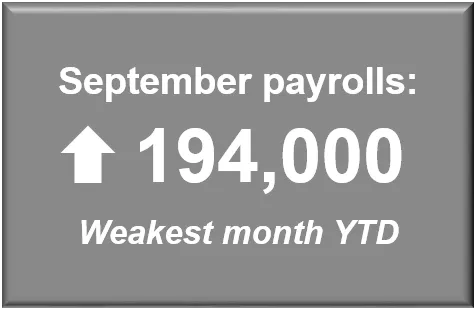October Economic Commentary: Recovery’s Path Remains Uneven

Chief Economist
Pohlad Companies
The uneven path of the economic recovery continues with recent reports confirming that economic growth is slowing toward more sustainable levels as the effects of the government stimulus from this spring abate. Concurrently, the lingering impact of the stimulus on consumer demand, coupled with ongoing supply-chain bottlenecks and the late summer surge of the Delta variant is complicating the timing of important policy decisions that face the Fed regarding the tapering of monetary policy.
Personal Consumption and GDP
Real personal consumption for the first two months of the third quarter is flat, and high-frequency data for September suggest that real consumption for the entire quarter is likely to be 0% - 2% annualized. That is quite a slowdown from the second quarter reading of 12%. No doubt, much of this can be attributed to COVID-19 and the inability of manufacturers to deliver products due to bottlenecks. As a result, estimates for the initial reading of third-quarter Real GDP have been falling and are now around 3%. For context, second-quarter Real GDP grew at a 6.7% annualized rate. The Fed has lowered their estimate for the entire year’s Real GDP growth from 7.0% to 5.9%.
Inflation
Inflationary pressures remain top of mind for the Fed. While several measures did ease slightly in August, year-over-year readings remain elevated, and concerns about more persistent cyclical inflation pressures are emerging. The acceleration of prices associated with the re-opening of the economy do appear to be easing, but other pricing pressures are developing in energy (oil prices at seven-year highs), along with continued wage escalation.
Interest Rates
Despite the concern about increasing inflation, interest rates remain historically low. When interest rates are below the level of inflation, savers are penalized as the interest they receive doesn’t keep up with price increases. This phenomenon is expected to persist for the foreseeable future as the Fed has made it clear that they are willing to tolerate higher inflation readings.
Employment
The employment report for September disappointed for the second month in a row. Non-farm payrolls increased by only 194,000 (the weakest monthly report this year) after an underwhelming increase of 366,000 in August. The unemployment rate fell from 5.2% to 4.8% but did so due to the shrinkage of the labor force by 183,000. The quality of available labor is the number one issue for small businesses. With the labor force contracting and job openings at record levels, it is no surprise that average hourly earnings are now growing at 4.6% year over year and are likely to continue moving higher. According to the latest NFIB survey, a record-high share of small firms plans to increase compensation to attract and retain employees.
All of this leaves the Fed in a challenging position while addressing their dual mandate of price stability and maximum employment. Chairman Powell has admitted that he has been surprised by the strength and persistence of the inflation readings. He has also said that the desired “sufficient progress in the labor market” has all but been met. Hence, it was expected that the Fed would announce the beginning of the tapering of their monthly asset purchases at their next meeting on November 3, but the two successive weak employment reports may change that timing. The Fed’s projection for the initial interest rate hike is late 2022 based on current assumptions by Fed members.
What to Watch
In short, the economy is moving back to trend-like growth rates. We are starting to see, however, that the unprecedented actions taken by policymakers over the past 18 months are having some unanticipated consequences that must be effectively addressed in order for the expansion to continue smoothly. And, of course, the path of COVID remains a wildcard to the best laid plans for the economy.
Insights
Research to help you make knowledgeable investment decisions
